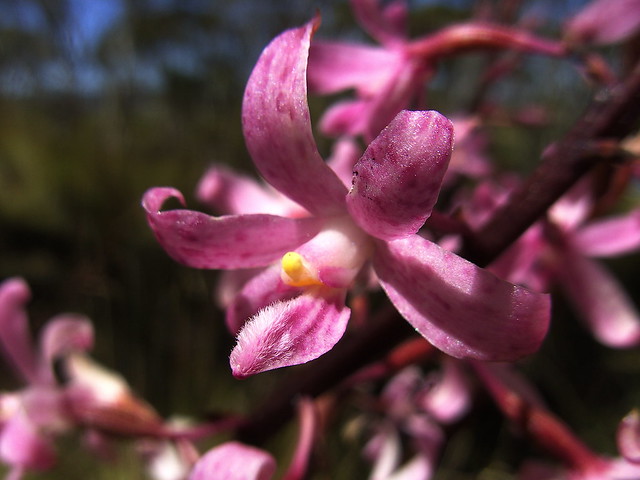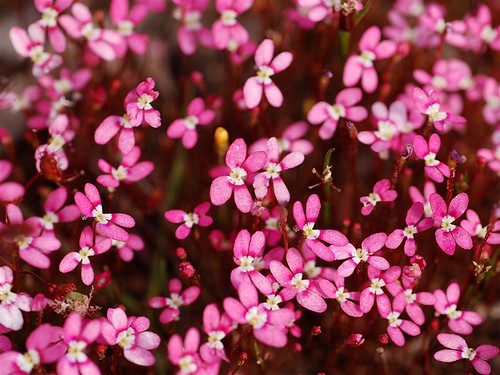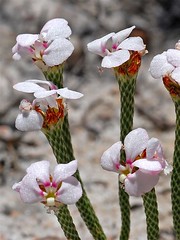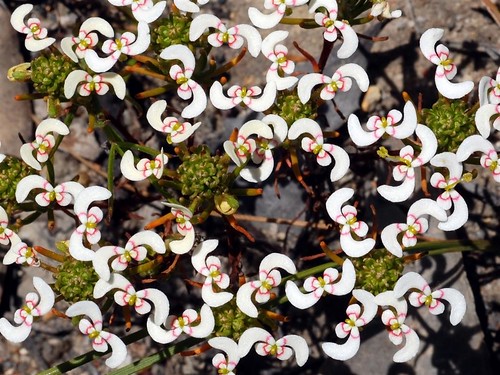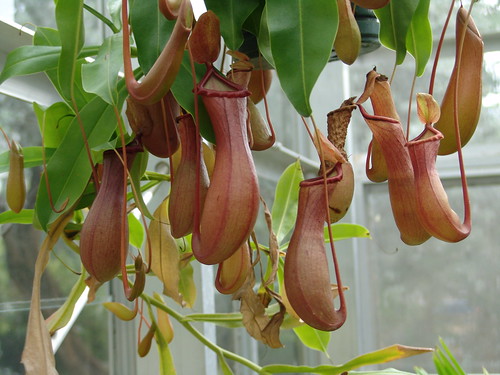 |
| Drosera glanduligera (pimpernel sundew) shown here in a figure from the new paper describing the fast-acting catapult traps (Poppinga et al., 2012). Creative Commons Attribution License. |
First, the study organism: Drosera glanduligera, the pimpernel sundew, an Australian native, was first described in 1844 by Johann Georg Christian Lehmann who was cataloging and describing new species found in the collections of the botanical garden that he established and directed in Hamburg (now called Alter Botanischer Garten Hamburg). My botanical Latin needs a good refresher, but at a quick glance it appears to me that Lehmann noticed enough to write down that the marginal tentacles of this species are larger, but that's the only observation he recorded. Indeed, as you can see in the photo above, the marginal tentacles are much longer than the glue-tentacles closer to the center of the leaf lamina (more on this later).
 |
| Drosera regia, king sundew. My plant in cultivation. |
Snap tentacles: Everyone is excited about this research - and rightly so - but what exactly are snap tentacles and how do they differ from regular tentacles on sundews? On most sundew species like this Drosera regia above and to the right, there is one kind of tentacle: a few-celled stalk supporting a multicellular, glandular, globular head. They vary in length from the center to the edge of the leaf but not in overall morphology. They produce and rely on a viscous mucilage to retain captured prey until the tentacles slowly move (in some species, if at all) and direct the prey toward the digestive glands at the center of the lamina. This can take minutes, even half an hour depending on temperature. The snap tentacles, on the other hand, produce no mucilage and typically have a faster movement. The multicellular head is modified and looks more like a spatula or a pillow resting on oversized spoon (or maybe like a catapult?). They quickly flip unsuspecting prey up and into the center of the remarkably sticky mucilage produced by other tentacles. In milliseconds the prey can reach a maximum velocity of 0.17 m/s and a maximum acceleration of 7.98 m/s. Before it can think or react, it's deposited in the lamina where it's immobilized and often suffocated by the mucilage. Any struggling is futile as other slower tentacles reposition the prey nearer the digestive glands. A few days later after the plant's enzymes have done their work, meal time is complete and new leaves are unfurling, awaiting new dinner guests.
About two years ago, two of the authors of the current study, Siggi and Irmgard Hartmeyer, published their findings on over 100 Drosera taxa in the Carnivorous Plant Newsletter while investigating snap tentacle morphology. They concluded that many species of Drosera from multiple points on the established phylogeny of the genus have snap tentacles of some kind at some point in their ontogeny that vary in how swift the response is. It's important to note, however, that in the 2010 paper they set aside the tentacles of Drosera glanduligera as something wholly different since it was the fastest and the mechanism wasn't quite clear. This may be the reason why we can refer broadly to snap tentacles and flypaper traps on all the species but this one alone has been granted the new term catapult-flypaper-trap.
For their part of the new study, Irmgard and Siggi cultivated the plants, captured new HD film, and created this documentary to accompany the paper's release. Now this is effective science communication (in German with captions in English). If you want to skip the beginning and see the plant in action, make your way to about the 5:00 mark.
So that's cool! A catapult that helps deliver prey in the center of the trap. What else did they find? I'm glad you asked. These tentacles move by some pretty awesome mechanisms since they're moving so quickly - did you watch the video? It completes that swing from laying on the ground to delivering the prey to the hungry center of the leaf in as little as 75 milliseconds. In their investigation, the research team found that these snap tentacles actually deform beyond the ability to "reset" in a resting position to fire once again like the Venus flytrap can. They hypothesize that the cells in the hinge zone actually buckle from the stress involved with the movement - nature's one use only device.
In the discussion, they spend a good bit of real estate on hypothesizing on the mechanism involved: is it rapid water movement from one side of the tentacle to the other or loss of turgor pressure in combination with what would essentially be the release of stored potential energy by a sudden geometric change or curvature inversion not unlike this child's toy (oh, you know you remember annoying your parents with one of those.) But they didn't find any noticeable inversion. This may not be all that different from other tentacle movement (and the initiation of movement in the Venus flytrap) where the acid growth hypothesis is supported. Simply, in acid growth a signal would cause H+ ions to be pumped out of the cell into the cell wall space where proteins in the cell wall matrix known as expansins loosen at an acidic pH (higher H+ concentration). That allows the cells to increase in size very rapidly. If you do this on only one side of the tentacle, the lower surface, the result would be rapid bending inward. There are ways to inhibit the transporters associated with acid growth, but it might take the skills of a fine surgeon to delicately and strategically place the inhibitors on the tentacles without prematurely triggering them!
Regardless, there are plenty of possibilities here for future research, much of which was identified by the authors themselves in the last few paragraphs. Congratulations all around for such an attention-grabbing paper that was even blamed, in part, for slowing down the PLOS website:
Ha! Our site slowdown blamed on mega-popularity of PLOSONE's carnivorous plant bit.ly/RlVHLu and Cannibis papers bit.ly/S3Oy53
— PLOS (@PLOS) September 27, 2012
References:
Poppinga, Simon, Siegfried R. H. Hartmeyer, Robin Seidel, Tom Masselter, Irmgard Hartmeyer, & Thomas Speck (2012). Catapulting Tentacles in a Sticky Carnivorous Plant. PLoS ONE, 7 (9): e45735. 10.1371/journal.pone.0045735
Hartmeyer, Irmgard, & Siegfried R. H. Hartmeyer (2010). Snap-tentacles and runway lights: summary of comparative examination of Drosera tentacles. Carnivorous Plant Newsletter, 39 (4), 101-113.
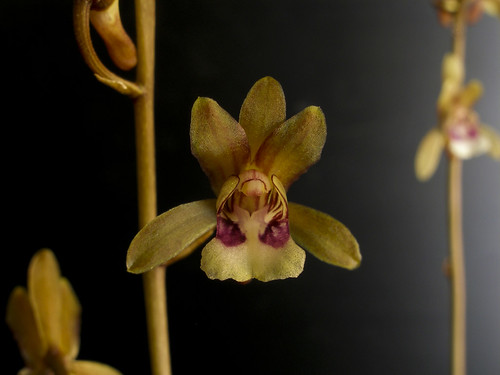
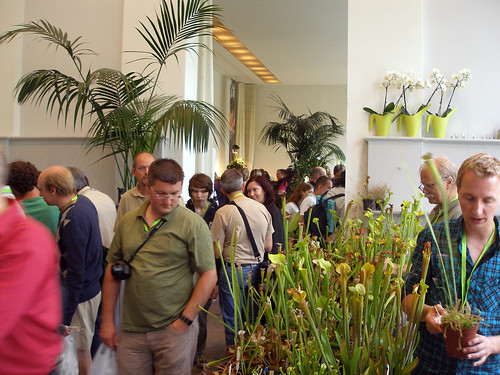




.jpg)




